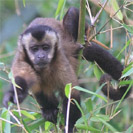Get
To Know
|
 The
Brown Capuchin Monkey is a New
World primate who lives
in the northern Amazon rainforest of the Guyanas, Venezuela and Brazil.
They are also found in eastern Colombia, Ecuador, Peru, including the
upper Andean Magdalena valley in Colombia, and a population was established
in the Republic of "Trinidad and Tobago". The capuchin has a head-body
length of 32 to 57 centimetres and a weight of 1.9 to 4.8 kilograms and
mostly
eats fruit, insects, larvae, eggs, young birds, frogs, lizards, and even
bats. They are also known to chase cats. They
can be found in many different kinds of environment, including moist tropical
and subtropical forest, dry forest, and disturbed or secondary forest.
They are social, and form groups of 8 to 15 individuals that are led by
an alpha male. Important
natural enemies of the capuchin are large birds of prey who they are so
afraid of that they even become alarmed when a harmless bird flies over.
The capuchin rubs urine on its hands and feet in order to attract mates
and reduce stress. They also use stones and sticks as tools. One population
of this species uses stones as a tool to open hard nuts. The monkey lays
the nut on a large, flat rock or fallen tree, hammering the nut with a
suitable stone until the nut cracks. The anvil rock is often pock-marked
with hollows as a result of repeated use. They have also
been observed using containers to hold water, using sticks (to dig nuts,
to dip for syrup, and to catch ants), using sponges to absorb juice, using
stones as hammer and chisel to penetrate a barrier, and using stones as
hammer and anvil to crack nuts. Some of these tasks seem relatively simple
by cognitive standards, but others, like cracking nuts with hammer and
anvil, are only exceeded in complexity by chimpanzees and some humans. The
Brown Capuchin Monkey is a New
World primate who lives
in the northern Amazon rainforest of the Guyanas, Venezuela and Brazil.
They are also found in eastern Colombia, Ecuador, Peru, including the
upper Andean Magdalena valley in Colombia, and a population was established
in the Republic of "Trinidad and Tobago". The capuchin has a head-body
length of 32 to 57 centimetres and a weight of 1.9 to 4.8 kilograms and
mostly
eats fruit, insects, larvae, eggs, young birds, frogs, lizards, and even
bats. They are also known to chase cats. They
can be found in many different kinds of environment, including moist tropical
and subtropical forest, dry forest, and disturbed or secondary forest.
They are social, and form groups of 8 to 15 individuals that are led by
an alpha male. Important
natural enemies of the capuchin are large birds of prey who they are so
afraid of that they even become alarmed when a harmless bird flies over.
The capuchin rubs urine on its hands and feet in order to attract mates
and reduce stress. They also use stones and sticks as tools. One population
of this species uses stones as a tool to open hard nuts. The monkey lays
the nut on a large, flat rock or fallen tree, hammering the nut with a
suitable stone until the nut cracks. The anvil rock is often pock-marked
with hollows as a result of repeated use. They have also
been observed using containers to hold water, using sticks (to dig nuts,
to dip for syrup, and to catch ants), using sponges to absorb juice, using
stones as hammer and chisel to penetrate a barrier, and using stones as
hammer and anvil to crack nuts. Some of these tasks seem relatively simple
by cognitive standards, but others, like cracking nuts with hammer and
anvil, are only exceeded in complexity by chimpanzees and some humans.
|
|
|
|
They're harmless, but you should be careful.
Assume that, however many years
have passed since they spoke, smiled,
or met someone's eye, if ever,
they're very aware of you.
Think of it this way - they'll try
to command the screen
where you try to arrange them without having
to smell them. Even they want
to direct. Would love
the jargon, the learnèd papers referred to
by parenthetical dates in your eventual
paper; though ideas, as you know,
follow images. Beware
the leaky crone in the wheelchair:
she thinks you're an admirer.
That chap you can barely see, in deep shadow,
postures and winks as he does to prove
he's brilliant.
Frederick Pollack is the author of two book-length narrative poems, The
Adventure and Happiness, both published by Story Line Press.
Other of his poems and essays have appeared in Hudson Review, Southern
Review, Fulcrum, Salmagundi, Poetry Salzburg Review, Die Gazette (Munich),
The Fish Anthology (Ireland), Representations and elsewhere.
Poems have most recently appeared in the print journals Magma (UK),
The Hat, Bateau, and Chiron Review. Online, poems have appeared
in Big Bridge, Snorkel, Hamilton Stone Review, Diagram, BlazeVox, The
New Hampshire Review, Mudlark, etc. Recent Web publications in Gloom
Cupboard, Blinking Cursor, Occupoetry, and Seltzer. Pollack
is an adjunct professor of creative writing at George Washington University,
Washington, DC.
|
 The
Brown Capuchin Monkey
- Issue Thirteen
The
Brown Capuchin Monkey
- Issue Thirteen